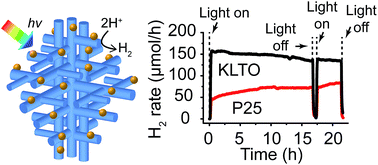Hyperbranched potassium lanthanum titanate perovskite photocatalysts for hydrogen generation†
Abstract
Semiconductors with hierarchical nanostructured morphologies may be promising as high surface area photocatalysts for producing hydrogen from water. However, there are few scalable synthesis methods that can achieve such morphologies in metal oxide semiconductors such as titanates. Here, hydrothermal methods were used to synthesize nanostructured potassium lanthanum titanate (KLTO) perovskite without using templates or structure-directing agents. The obtained materials were octahedral particles composed of orthogonal hyperbranched nanowires, a morphology that is usually obtained using catalyst-mediated vapor phase methods. Several fundamental materials properties of KLTO were determined for the first time, including the bandgap (3.3 eV), semiconductor type (n-type), flat band potential, and conduction band maximum (−0.265 V and −0.835 V vs. NHE, respectively). The KLTO hyperbranched structures were also investigated as UV-photocatalysts for H2 production and displayed higher activities than P25 TiO2 and KLTO nanoparticles. The H2 production rate for KLTO decorated with 1 wt% Pt using thermal decomposition of K2PtCl4 reached ca. 2.5 mmol h−1 and was stable for 20 h of irradiation.

- This article is part of the themed collection: Water splitting and photocatalysis

 Please wait while we load your content...
Please wait while we load your content...